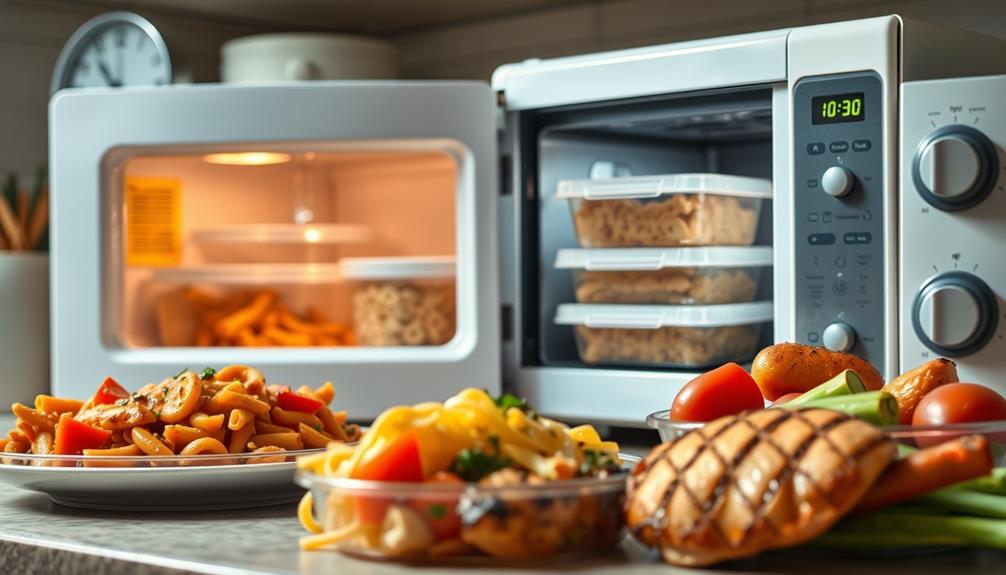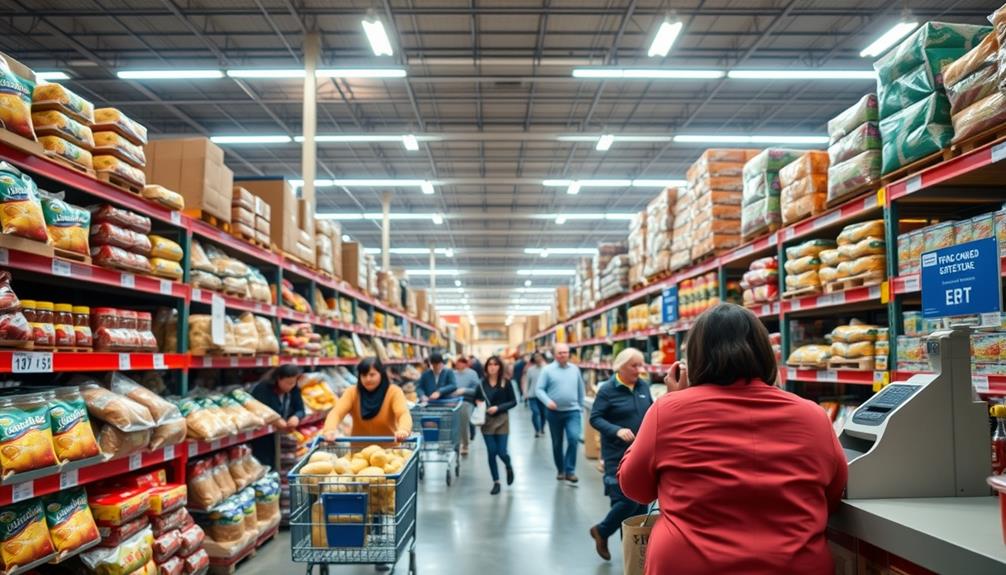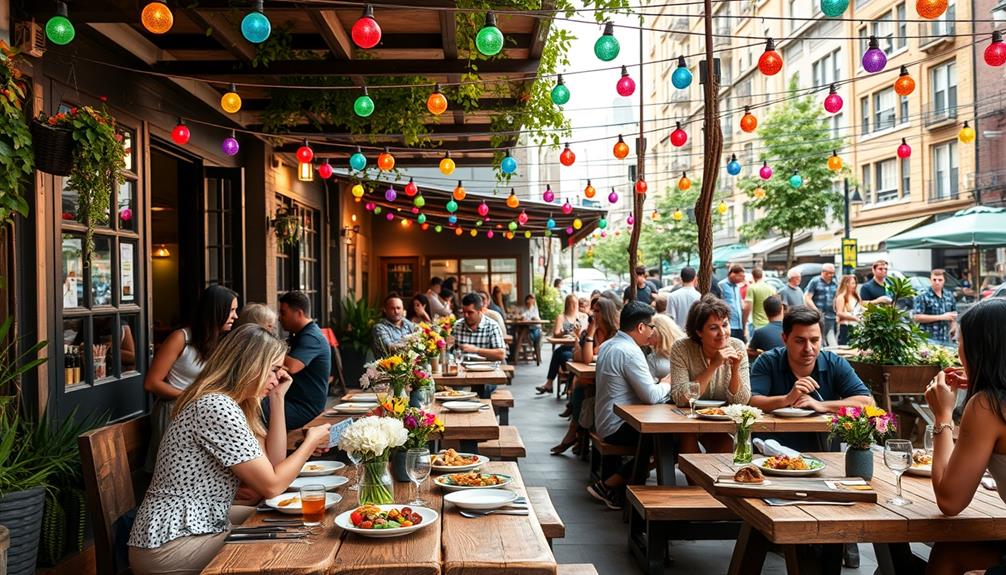Restaurant leftovers are good for up to four days if you refrigerate them promptly. Make sure to store them within two hours, or within one hour if the temperature's over 90°F. Beyond four days, the risk of foodborne illness increases, so it's best to toss anything questionable. If you can't eat them in time, consider freezing leftovers for two to six months. When reheating, aim for an internal temperature of 165°F. Following these guidelines keeps you safe from harmful bacteria. Curious about more food safety tips and best practices? You'll want to explore what's next.
Key Takeaways
- Refrigerate restaurant leftovers within two hours to prevent harmful bacterial growth; within one hour if the temperature exceeds 90°F.
- Consume leftovers within 4 days for safety; if not eaten, freeze them at 0°F for 2 to 6 months.
- Reheat leftovers to an internal temperature of 165°F; soups and sauces should be brought to a boil.
- Use airtight containers for storage, label and date them, and avoid overcrowding in the refrigerator for proper air circulation.
- Discard any perishable food left out for more than 2 hours to minimize foodborne illness risks.
Importance of Timely Refrigeration

When it comes to restaurant leftovers, timely refrigeration is vital. You should refrigerate your leftovers within two hours of dining to minimize the risk of bacterial growth. Remember, harmful bacteria can double in number every 20 minutes at room temperature. If the temperature exceeds 90°F, you need to act even faster—refrigerate those perishable foods within one hour.
Additionally, it's important to take into account the quality of the food you're storing; some cold medications can interact negatively with certain foods, impacting your overall health cold medications overview.
Letting leftovers sit out for more than two hours greatly increases the risk of foodborne illness. Prioritizing prompt refrigeration not only protects your health but also maintains the quality and flavor of the food. You want to enjoy your meal again, right? By storing leftovers immediately, you reduce the chance of foodborne pathogens developing, which is vital for food safety.
Make it a habit to monitor the time elapsed since your meal. If you plan to have a late-night snack or lunch the next day, make sure those leftovers are stored correctly. Your stomach will thank you, and you'll avoid the unpleasant consequences of spoiled food.
Taking these simple steps can make a big difference in enjoying your restaurant leftovers safely and deliciously.
Safe Storage Duration

Many people wonder how long restaurant leftovers can safely last in the fridge. To minimize the risk of foodborne illness, you should consume those leftovers within 4 days. Keeping them at a constant refrigerator temperature of 40°F helps maintain their safety.
If you haven't eaten them by then, consider freezing leftovers at 0°F. This guarantees ideal quality preservation, allowing you to enjoy them for 2 to 6 months. Understanding proper budgeting for food expenses can also help you make the most of your dining experiences and reduce waste.
Be mindful of how long perishable items sit at room temperature. If they're left out for more than 2 hours, it's best to discard them, especially if the temperature exceeds 90°F, which shortens that safe window to just 1 hour.
Specific items have different safe storage durations; for instance, cooked seafood should be eaten within 1-2 days, while smoked fish can last up to 14 days in the refrigerator if stored correctly.
To guarantee your food remains safe, always monitor the condition and dates of your leftovers. If anything exceeds its recommended storage duration, don't hesitate to throw it away to avoid health risks.
Reheating Guidelines

When you're ready to enjoy those restaurant leftovers, it's vital to reheat them to an internal temperature of 165°F to guarantee they're safe to eat.
Proper food storage and reheating practices can help prevent foodborne illnesses, similar to how proper diet and care are essential for pet health.
If you're using a microwave, remember to stir your food halfway through to heat it evenly.
Let's look at some effective reheating tips to keep your meals both delicious and safe.
Safe Reheating Temperature
Reheating leftovers safely is crucial to prevent foodborne illnesses. To keep your meals safe to eat, always reheat your food to an internal temperature of 165°F. This temperature effectively kills any harmful bacteria that may have developed while the food was stored.
Using a food thermometer is key; it guarantees that you accurately check the internal temperature of your reheated food. It's also important to guarantee proper airflow around your reheating appliance, as this can enhance performance and safety, similar to how air purifier maintenance dos and don'ts help maintain a clean environment.
When dealing with soups, sauces, and gravies, bring them to a boil during reheating. This method ensures thorough heating and safety. It's important to avoid using slow cookers for reheating leftovers, as they can extend the time food spends in the temperature danger zone, which ranges from 40°F to 140°F. In this zone, harmful bacteria thrive, putting your health at risk.
If you're reheating in the oven, remember to set the temperature at 325°F or higher. This helps the food reach a safe internal temperature quickly, minimizing the risk of foodborne illnesses.
Microwave Reheating Tips
To enjoy your restaurant leftovers without compromising safety or taste, follow some essential microwave reheating tips.
First, always use microwave-safe plates. This guarantees you prevent harmful chemicals from leaching into your food. Additionally, be mindful that some leftovers can be high in fat and sugar, similar to ice cream health considerations, so balancing your meal is key.
Spread your leftovers evenly on the plate for uniform heating, which helps minimize cold spots that can harbor bacteria.
When reheating, cover your food with a microwave-safe lid or plastic wrap. This retains moisture and enhances heating efficiency. Stirring your dish halfway through the reheating process promotes even heating and eliminates any potential cold spots, further guaranteeing food safety.
It's vital to monitor heating times closely. Microwaves can easily overcook food, making it tough or rubbery. Start with shorter intervals and check the temperature regularly.
Recognizing Food Safety Risks

When you’re enjoying restaurant leftovers, keep in mind that harmful bacteria like E. coli and salmonella can’t be seen or tasted. To minimize the risk of foodborne illnesses, it’s essential to store your leftovers properly and consume them within a few days. Always reheat meals to the appropriate temperature, as this can kill any harmful bacteria that may have developed. If you’re looking for budget-friendly dining options, consider exploring restaurants that accept EBT benefits, which can provide affordable meals while still ensuring food safety practices are followed.
Individuals with certain conditions, such as emotional dysregulation, may be at a higher risk of making impulsive food choices, which can lead to unsafe practices.
If you're part of a high-risk population, like young children or the elderly, you need to be especially cautious.
Always prioritize food safety to protect yourself and your loved ones from potential health risks.
Invisible Bacteria Threats
Invisible bacteria can pose serious food safety risks, making it fundamental to understand their presence in restaurant leftovers. Harmful bacteria like E. coli and salmonella are often undetectable, which can lead to foodborne illnesses if you're not careful.
For instance, practicing proper food handling and storage is critical to mitigate these risks, especially when considering tips for yoga for back pain that emphasize holistic management. The temperature danger zone, between 40°F and 140°F, is where these pathogens thrive, doubling every 20 minutes if food is left out at room temperature.
It's important to remember that visual inspections aren't enough. Just because food looks fine doesn't mean it's safe. Mold can indicate spoilage, but invisible pathogens may still linger.
By neglecting proper food safety practices, you increase the risk of contamination, especially for vulnerable populations like children and the elderly.
Understanding the symptoms of foodborne illnesses, such as nausea and diarrhea, can help you recognize the consequences of consuming contaminated leftovers. When in doubt, it's better to throw food away than to risk your health or that of others.
Reducing food waste is fundamental, but not at the expense of safety. Always prioritize proper handling and storage to keep your leftovers safe for consumption.
High-Risk Populations
Understanding the risks associated with restaurant leftovers becomes even more important for high-risk populations. These groups, including young children, the elderly, pregnant women, and individuals with weakened immune systems, are particularly susceptible to foodborne illness. Even small amounts of harmful bacteria in leftovers can lead to severe symptoms like nausea, vomiting, and diarrhea.
Additionally, it's vital to recognize that the emotional impact of food safety concerns can weigh heavily on individuals caring for these vulnerable groups, making adherence to safety protocols even more vital financial implications during divorce.
To protect yourself and your loved ones, it's important to follow food safety guidelines strictly. Always refrigerate leftovers within 2 hours to minimize bacterial growth. If you let them sit out longer, you increase the risk of harmful microorganisms multiplying, which can be dangerous for vulnerable groups.
Cross-contamination is another significant risk for high-risk populations. Be sure to handle and store leftovers carefully to avoid exposure to pathogens. Use separate containers for different types of food and always wash your hands before handling leftovers.
Awareness of food safety risks is essential. By taking these precautions, you can help safeguard the health and well-being of high-risk individuals when consuming restaurant leftovers.
Best Practices for Packing Leftovers

To guarantee your restaurant leftovers stay fresh and safe to eat, it's essential to pack them properly right after your meal.
Following best practices, like those seen in the context of home security systems for safeguarding your property, can also apply to food safety.
Here are some important tips to make sure your food remains delicious and safe:
- Use airtight containers: Choose food-grade, airtight containers to store leftovers. This helps preserve freshness and prevent contamination.
- Refrigerate within two hours: Always refrigerate your leftovers within two hours of dining out. If the temperature exceeds 90°F, you should do this within one hour to minimize bacterial growth.
- Label and date: Clearly label and date all containers. This keeps track of when you stored the leftovers and guarantees you use them within the recommended 3-4 days for safety.
- Avoid overcrowding: Make sure to avoid overcrowding in the refrigerator. Proper air circulation around containers is critical for maintaining food safety and quality.
Resources for Food Safety

When it comes to guaranteeing the safety of your restaurant leftovers, having access to reliable resources can make all the difference. The USDA offers expert advice through its Meat and Poultry Hotline at 1-888-MPHotline (1-888-674-6854), where you can ask questions about food safety.
For quick queries, utilize their live chat at ask.usda.gov, available from 10 a.m. to 6 p.m. ET. Additionally, understanding the importance of financial considerations for elderly care can provide context for families managing food safety, especially when caring for seniors who may have specific dietary needs.
To prevent foodborne illness, it's vital to follow the USDA's guidelines on handling, storing, and reheating leftovers. Keeping your leftovers in the fridge at the right temperature is necessary. A food thermometer can help you verify that your food is reheated to a safe temperature, reducing the risk of illness.
To track ideal storage times for various foods, including your restaurant leftovers, consider downloading the FoodKeeper App. This handy tool provides valuable information on how long different foods can be safely stored.
Staying updated with the latest food safety practices through USDA's websites can enhance your Food Safety Education and empower you to make informed decisions about your leftovers.
Frequently Asked Questions
Are Leftovers Good After 7 Days?
Leftovers aren't safe after 7 days. Even if they look fine, harmful bacteria can develop without visible signs. It's best to trust your instincts; if in doubt, throw them out to avoid illness.
Can You Eat Cooked Meat After 5 Days?
Imagine a ticking clock, reminding you of time's fleeting nature. After 5 days, eating cooked meat isn't wise; risks of spoilage rise. If unsure, trust your instincts—better safe than sorry. Discard it!
Is It Safe to Reheat Restaurant Leftovers?
Yes, it's safe to reheat restaurant leftovers, but make sure you heat them to 165°F. Use a food thermometer, cover your food while microwaving, and only reheat once to avoid potential bacteria growth.
How Long Is Leftover Chick-Fil-A Good For?
Leftover Chick-Fil-A's good for 3-4 days if you store it properly in an airtight container. Reheat it to 165°F to guarantee it's safe and tasty. Enjoy it within 3 days for the best flavor!
Conclusion
To keep your restaurant leftovers safe and tasty, remember to refrigerate them within two hours of receiving your meal. Generally, they're good for about three to four days in the fridge. Did you know that nearly 40% of food in the U.S. goes to waste? By following these guidelines, you not only enjoy your leftovers but also help reduce that staggering statistic. So, pack them right, store them well, and savor every bite!









